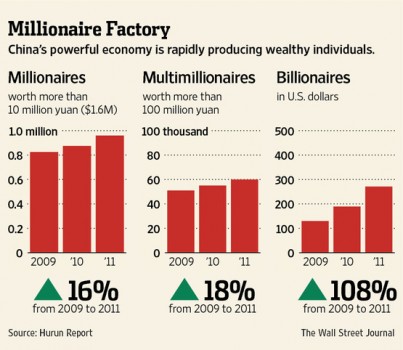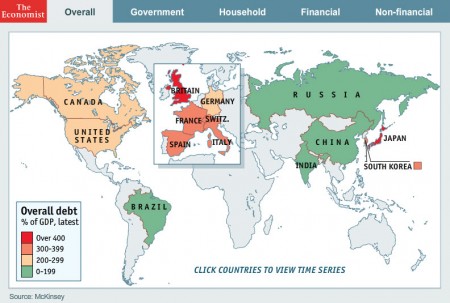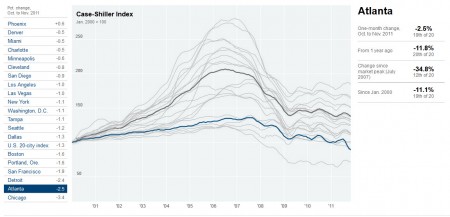Great leap backward
How the Great Recession and European debt crisis have turned back the growth “clock” of most advanced economies, sometimes more than ten years. Looks like Ken Rogoff was right: this is not Great Recession; it’s Great Contraction.
[singlepic id=43 w=600 h=450 float=]
Source: Economist Mag.
The exodus of Chinese rich
According to WSJ, one recent survey found that 60% of about 960,000 Chinese people with assets over 10 million yuan ($1.6 million) were either thinking about emigrating or taking steps to do so. The U.S. was the top destination, followed by Canada, Singapore and Europe. Most people cited their children’s education as the main reason, followed by concerns over air quality, food safety and financial security.
Here is a snapshot of China’s new millionaires:
And the related WSJ video interview.
World Debt Map
Mapping the world’s debt problem, from Economist Magazine:
(click on the graph to go to the interactive chart)
Troubling development in US housing market
Atlanta, Charlotte, Boston, Denver and Dallas were the cities that fared relatively well when the US housing bubble went bust: housing prices in these cities, until 2010, had only declined 10-20%, much better than the 50% average price drop in cities like Phoenix, Miami and Las Vegas.
But the recent price trend is worrisome: prices in these markets started to decline, sometimes at a faster pace than national average. The extreme example is Atlanta. Last year, the price in the southern city dropped 12%, the largest yearly drop among all major cities. (see the dynamic chart below, from NYT).
It remains to be seen whether the price dropping in these cities will pick up and eventually catch up with the national average. The key focus lies on how soon the labor market is likely to recover. Without jobs and robust income growth, more people will be forced out their homes, which will lead to another round of price decline.
Folks at CalculatedRisk also have a very nice chart showing the cumulative housing price declines by cities.
[singlepic id=42 w=400 h=300 float=]
Get real perspective on America’s unemployment
Wells Fargo has a nice chart depicting the relationship between real GDP growth and the change of unemployment rate, the so-called Okun’s Law:
[singlepic id=40 w=400 h=300 float=]
The two are negatively correlated. From regressional analysis, for unemployment rate to drop, the minimum real GDP growth rate required, on average, should be 3.4%. But the actual growth rate in 2011 was only 1.6%. So why have we been witnessing a drop of unemployment rate anyway?
The breakdown of this long-run relationship may be due to the drop of participation rate in labor market. The real unemployment rate, taking participation rate into account, should be much higher.
As shown in the graph, the current change of unemployment rate would require a much faster real GDP growth, at roughly 5%, three times of the current growth rate.
China GDP per capita, huge regional gap
Following my previous post on China’s fast catching-up with the developed countries, Economist Magazine has done some more interesting map works, matching China’s output-income data by provinces to the world’s individual countries. The map vividly shows the huge income gap among different Chinese provinces/regions.
More similar maps here.




